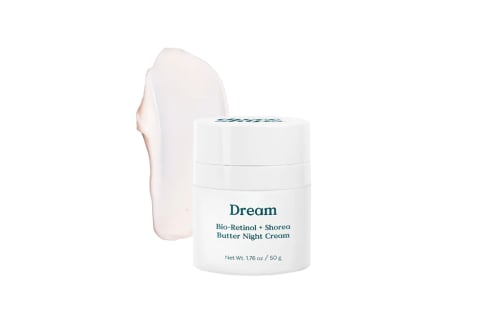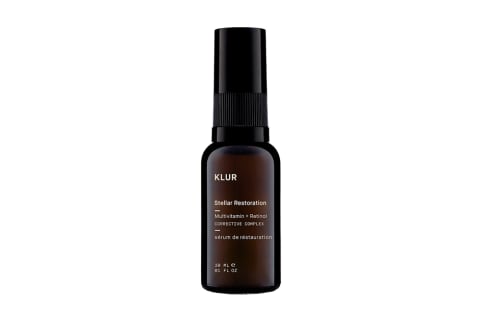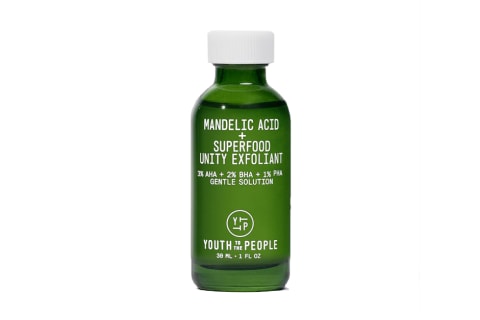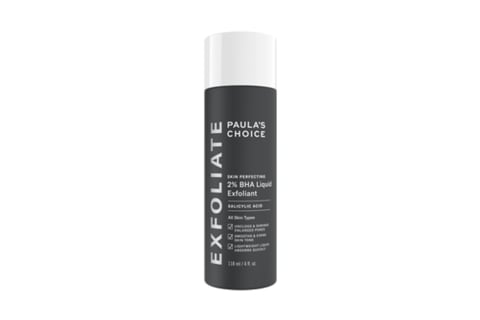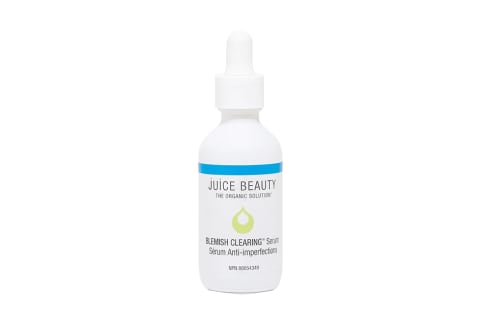Salicylic Acid & Retinol Together: What The Pros Say


With all of the talk about how beneficial salicylic acid and retinol are for the skin (especially for those prone to breakouts), it's only reasonable to want to know if they can be used in the same routine.
However, since they are both very powerful ingredients, it's essential that you know how to do so responsibly—otherwise, you can seriously damage the skin barrier, or even render the products ineffective. To help you out, we've compiled everything you need to know in one story, all from experts. Let's dive in.
What is retinol?
Before we get into the logistics of combining these products into one routine, let's get to know each powerhouse ingredient. Up first, we have retinol. At its core, retinol is a topical form of vitamin A.
A quick caveat, the term "retinoid" encompasses all forms of retinol, including both over-the-counter and prescription-grade formulas. The difference between the two categories tends to be the strength, as OTC formulas are generally less potent.
If you're not sure whether or not you should shoot for prescription products or OTC serums, this story will help you out.
Benefits of retinol.
There are plenty of benefits to using retinol, and not just for aging skin alone. Here's a quick summary:
- Promotes collagen production. This effect was observed in a human study, where retinol treatment stimulated collagen production1 in mature skin, helping to decrease the appearance of wrinkling.
- Improves fine lines, tone, and texture. Retinol's ability to support cell turnover and collagen production, becomes especially useful as we age—tending to pigmentation concerns, wrinkles, and uneven texture.
- Treats acne. As retinol interacts with the skin cells' receptors, it beneficially alters the genes involved with inflammation and cell growth. This reduces the formation of microcomedones2, or skin pores clogged with sebum, bacteria, and dead skin cells.
- Increases cell turnover. Retinol speeds up the life cycle of the cell3, which improves cell turnover. This can help with both breakouts and dullness.
What is salicylic acid?
Salicylic acid is a beta-hydroxy acid (aka BHA), which means it's oil- and fat-soluble. In plain terms, this acid can basically break through the oiliest skin, shimmying deep inside the pores to help unclog them at the source. As a result, it can help exfoliate the skin and remove excess oil, as well as balance sebum levels.
"Salicylic acid was originally from willow bark trees," board-certified dermatologist Anar Mikailov, M.D., FAAD, founder of KP Away said about the ingredient. "But nowadays salicylic acid is mostly synthetically produced, either via biosynthesis or via commercial production."
Benefits of salicylic acid.
Why use it? There are plenty of reasons, especially for those that may be prone to breakouts, both occasional or chronic.
- Regulates oil production.In this 2014 study4, researchers found that using salicylic acid directly impacts sebum production. This is essential for those with oily and acne-prone skin, as sebum can clog the pores and trigger breakouts.
- Treats acne. Because salicylic acid is a multitasking ingredient, it treats acne in many ways, from exfoliating to managing bacteria and regulating sebum production. It's no wonder clinical studies deem this ingredient a safe and effective treatment for5 breakouts5.
- Brightens the skin. What's more, salicylic acid can brighten the skin—dark spots and melasma included. Plus, it's safe to use on all skin tones5—something that can't be said for many popular brightening agents.
- A powerful exfoliator. Chemical exfoliants, like salicylic acid, gently dissolve dead skin cells, which can keep your complexion looking more youthful and radiant over time.
Let's settle this: Can you use them at the same time?
The question you've been asking: Can you use both ingredients simultaneously? The short answer is no, you probably shouldn't. "Mixing salicylic acid and retinol can lead to increased irritation, especially in someone who is prone to dry or sensitive skin," board-certified dermatologist and founder of Maei MD Rebecca Marcus, M.D., FAAD, tells mbg.
Retinol is a notoriously unstable ingredient and should be used with care, so you'll want to proceed with caution whenever pairing it with another product in one setting. The goal here is to isolate your active ingredients (read: use one active per sitting).
"Salicylic acid and retinol can be used simultaneously, as long as they are not applied at the same time," board-certified dermatologist and founder of NicholsMD of Greenwich Kim Nichols, M.D., FAAD, tells mbg.
"You want to leave enough time in between the application process for each ingredient to deliver optimal results," she adds. In general, this means applying the ingredients at different times of the day, Nichols suggests.
You can also apply them on different nights (aka practice skin cycling). More on that in a bit. However, we must remind you that these ingredients are powerful, so using both of them every day might be a bit much for your skin, especially if you're prone to irritation.
5 ways to use retinol & salicylic acid in the same routine.
So, let's get into logistics—how can you use these two in the same routine? Here are a few different methods to consider:
Apply retinol at night and SA during the day.
"Typically, it is recommended to use salicylic acid during the day and retinol at night, as some retinoids are considered photolabile, which means they may become unstable and break down when exposed to the sun, making them less effective when used during the day," Marcus notes.
"Both ingredients may cause you to be more sensitive in the sun, so regardless of which one is used during the day or at night, it is important to wear sun protection," she adds. We repeat: Wear your SPF every single day.
Practice skin cycling.
If you're prone to sensitivity, then skin cycling might be a better option than using the two on separate nights. Here's how to do it, from board-certified dermatologist and founder of Dr. Whitney Bowe Beauty Whitney Bowe, M.D., FAAD.
- Night 1: Exfoliation night. This means using a chemical exfoliant (or a gentle physical scrub). For chemical exfoliators, you can choose from salicylic acid or another AHA or PHA. The reason exfoliation is before the retinoid night is that these ingredients slough off dead skin cells, meaning your retinol product can penetrate the skin even deeper (thus working better).
- Night 2: Retinoid night. On this evening, use any form of retinol you feel comfortable with. This could be a gentle over-the-counter product or a prescription-grade cream (if your derm gives it to you).
- Nights 3 & 4: Recovery night. On the third and fourth night of your routine, don't use either of the actives listed above. These rest days are designed to let your skin recover. By scheduling these restorative treatment nights, you'll prevent over-exfoliation, retinoid reactions, and the like (all of which can lead to irritation, bumpy texture, dryness, and redness).
For those with acne-prone skin, you may be able to cut your skin cycling routine down to three nights, reserving just one evening for recovery. To learn more about skin cycling and how to master this process for your skin type, check out our full guide here.
Use SA masks weekly but retinol regularly.
When you think of salicylic acid, you might immediately picture a serum. However, you can use this ingredient in mask form as well.
"Salicylic acid masks once or even twice per week are beneficial for detoxifying the skin of impurities, fighting inflammation, and soothing the skin whilst incorporating some hydration and offering brightening and skin-smoothing attributes," Heyday's Esthetician and Skincare Educator Glenise Gomez tells mbg.
"Dry skin will prefer a hydrating mask, as the actives have a gentle delivery, while oily skin can benefit from a clay base," she explains.
It's still best practice to use the salicylic acid mask on the night that you're designating exfoliation night rather than using it before retinol.
Use a salicylic acid cleanser.
Some (emphasis on some) skin types may benefit from using a daily salicylic acid cleanser, which can be followed by a retinol serum, Marcus says. For most folks this will be too drying if used back-to-back. If you’d like to fold in a salicylic acid cleanser, we suggest using that as you morning wash and retinol in the evening.
And sensitive skin types should stick with gentle cleansers and use a salicylic acid cleanser every few nights rather than on a daily cadence.
Best retinol products
Best salicylic acid products
FAQ
How long after using salicylic acid can you use retinol?
You shouldn't use retinol and salicylic acid in the same sitting. Instead, use salicylic acid in the morning and retinol at night, or use them on different nights throughout the week.
Can I use salicylic acid and retinol on different days?
Yes, using salicylic acid and retinol on different days is a great combination for those with oily or acne-prone skin.
Can you use salicylic acid and retinol on the same day?
You can use salicylic acid and retinol on the same day if you use them at different times. Use salicylic acid in the morning and retinol at night, as the latter is sensitive to UV light. Be sure to wear SPF during the day if you're using either of these ingredients, as they make your skin more sensitive to sun rays.
The takeaway.
Salicylic acid and retinol are great ingredients to use for anyone with oily or acne-prone skin. However, they should not be used at the same time. Instead, use the two ingredients on different nights, use a salicylic acid cleanser, or use a salicylic acid mask throughout the week. Looking for more ways to ease breakouts? Check out our full guide to managing acne here.

Hannah Frye is the Assistant Beauty & Health Editor at mindbodygreen. She has a B.S. in journalism and a minor in women’s, gender, and queer studies from California Polytechnic State University, San Luis Obispo. Hannah has written across lifestyle sections including skin care, women’s health, mental health, sustainability, social media trends, and more. She previously interned for Almost 30, a top-rated health and wellness podcast. In her current role, Hannah reports on the latest beauty trends and innovations, women’s health research, brain health news, and plenty more.

